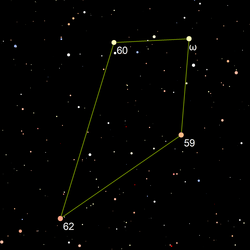60 Sagittarii
60 Sagittarii is a suspected binary star[10] system in the southern constellation of Sagittarius. It has the Bayer designation A Sagittarii, while 60 Sagittarii is the Flamsteed designation. This naked eye object forms the northwest corner of the asterism called the Terebellum and, with an apparent magnitude of approximately 4.84,[2] it is the dimmest of the four stars in the Terebellum. It is located 379 light years from the Sun, based on parallax, but is moving closer with a radial velocity of −51 km/s.[2]
 The four stars of the Terebellum | |
| Observation data Epoch J2000.0 Equinox J2000.0 (ICRS) | |
|---|---|
| Constellation | Sagittarius |
| Right ascension | 19h 58m 57.20292s[1] |
| Declination | −26° 11′ 44.7585″[1] |
| Apparent magnitude (V) | 4.84[2] |
| Characteristics | |
| Evolutionary stage | horizontal branch[3] |
| Spectral type | G6 III[4] |
| U−B color index | +0.55[5] |
| B−V color index | +0.882±0.038[2] |
| R−I color index | +0.47[5] |
| Astrometry | |
| Radial velocity (Rv) | −51.1±2.4[2] km/s |
| Proper motion (μ) | RA: +35.31[6] mas/yr Dec.: +25.69[6] mas/yr |
| Parallax (π) | 8.6025 ± 0.1732[1] mas |
| Distance | 379 ± 8 ly (116 ± 2 pc) |
| Absolute magnitude (MV) | −0.07[2] |
| Details | |
| Radius | 17.42+0.68 −0.80[1] R☉ |
| Luminosity | 170.3±4.0[1] L☉ |
| Surface gravity (log g) | 2.78[7] cgs |
| Temperature | 4,997+119 −96[1] K |
| Metallicity [Fe/H] | −0.38[7] dex |
| Other designations | |
| Database references | |
| SIMBAD | data |
The visible component is an aging G-type giant star with a stellar classification of G6 III,[4] having exhausted the supply of hydrogen at its core and expanded to 17[1] the Sun's radius. In the Bright Star Catalogue it was listed with a class of G6 III Ba0.2,[5] suggesting it is a mild barium star and thus might have a white dwarf companion.[10] It is a red clump giant, indicating it is on the horizontal branch and is generating energy through the fusion of helium at its core.[3] The star is radiating 170[1] times the luminosity of the Sun from its enlarged photosphere at an effective temperature of 4,997 K.[1]
References
- Brown, A. G. A.; et al. (Gaia collaboration) (August 2018). "Gaia Data Release 2: Summary of the contents and survey properties". Astronomy & Astrophysics. 616. A1. arXiv:1804.09365. Bibcode:2018A&A...616A...1G. doi:10.1051/0004-6361/201833051. Gaia DR2 record for this source at VizieR.
- Anderson, E.; Francis, Ch. (2012), "XHIP: An extended hipparcos compilation", Astronomy Letters, 38 (5): 331, arXiv:1108.4971, Bibcode:2012AstL...38..331A, doi:10.1134/S1063773712050015.
- Alves, David R. (August 2000), "K-Band Calibration of the Red Clump Luminosity", The Astrophysical Journal, 539 (2): 732–741, arXiv:astro-ph/0003329, Bibcode:2000ApJ...539..732A, doi:10.1086/309278.
- Keenan, Philip C.; McNeil, Raymond C. (1989), "The Perkins catalog of revised MK types for the cooler stars", Astrophysical Journal Supplement Series, 71: 245, Bibcode:1989ApJS...71..245K, doi:10.1086/191373.
- Hoffleit, D.; Warren, Jr., W. H., "HR 7618, database record", The Bright Star Catalogue (5th Revised ed.), CDS. ID V/50. Accessed on line November 19, 2009.
- van Leeuwen, F. (2007), "Validation of the new Hipparcos reduction", Astronomy and Astrophysics, 474 (2): 653–664, arXiv:0708.1752, Bibcode:2007A&A...474..653V, doi:10.1051/0004-6361:20078357.
- Alves, S.; et al. (April 2015), "Determination of the spectroscopic stellar parameters for 257 field giant stars", Monthly Notices of the Royal Astronomical Society, 448 (3): 2749–2765, arXiv:1503.02556, Bibcode:2015MNRAS.448.2749A, doi:10.1093/mnras/stv189.
- Kostjuk, N. D. (2002), "HD 189005, database record", HD-DM-GC-HR-HIP-Bayer-Flamsteed Cross Index, Institute of Astronomy of Russian Academy of Sciences. CDS ID IV/27. Accessed on line November 19, 2009.
- "60 Sgr A". SIMBAD. Centre de données astronomiques de Strasbourg. Retrieved 2019-08-04.
- Eggleton, P. P.; Tokovinin, A. A. (2008), "A catalogue of multiplicity among bright stellar systems", Monthly Notices of the Royal Astronomical Society, 389 (2): 869, arXiv:0806.2878, Bibcode:2008MNRAS.389..869E, doi:10.1111/j.1365-2966.2008.13596.x.